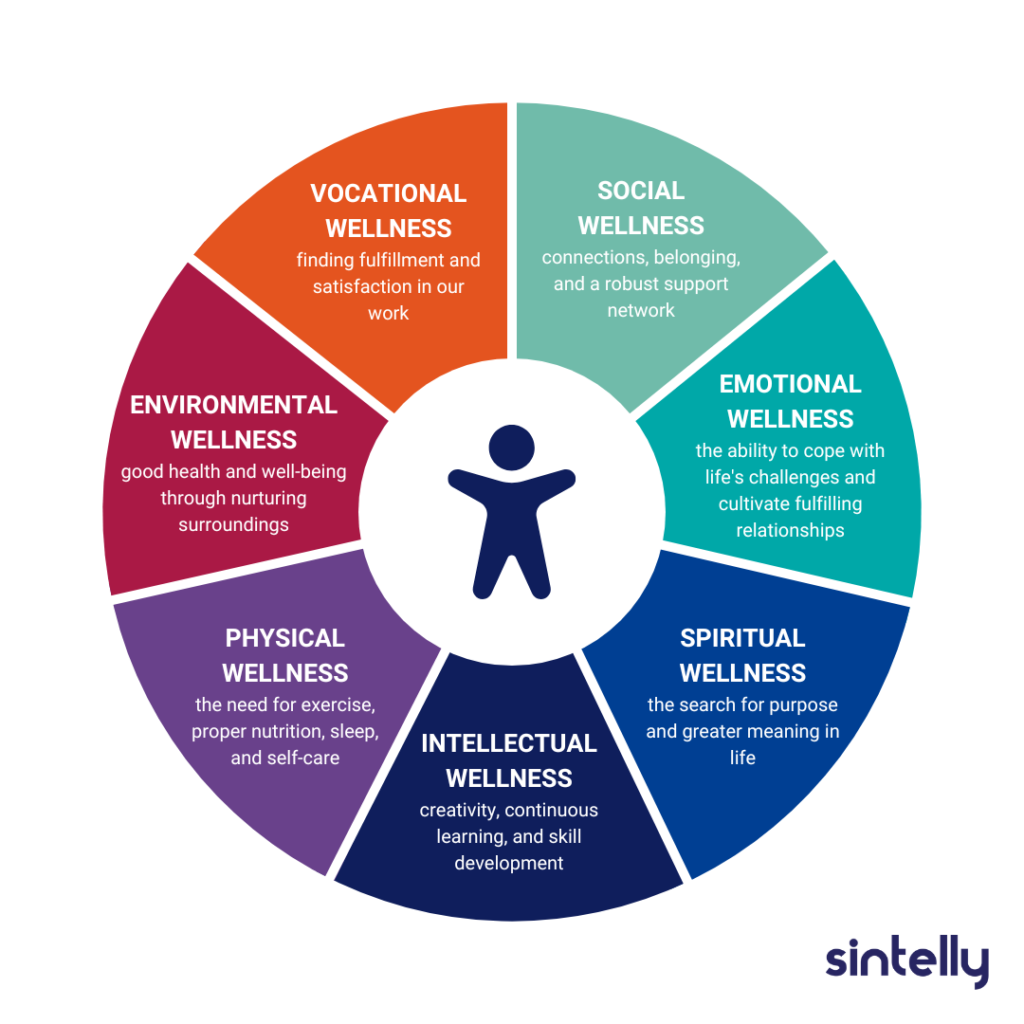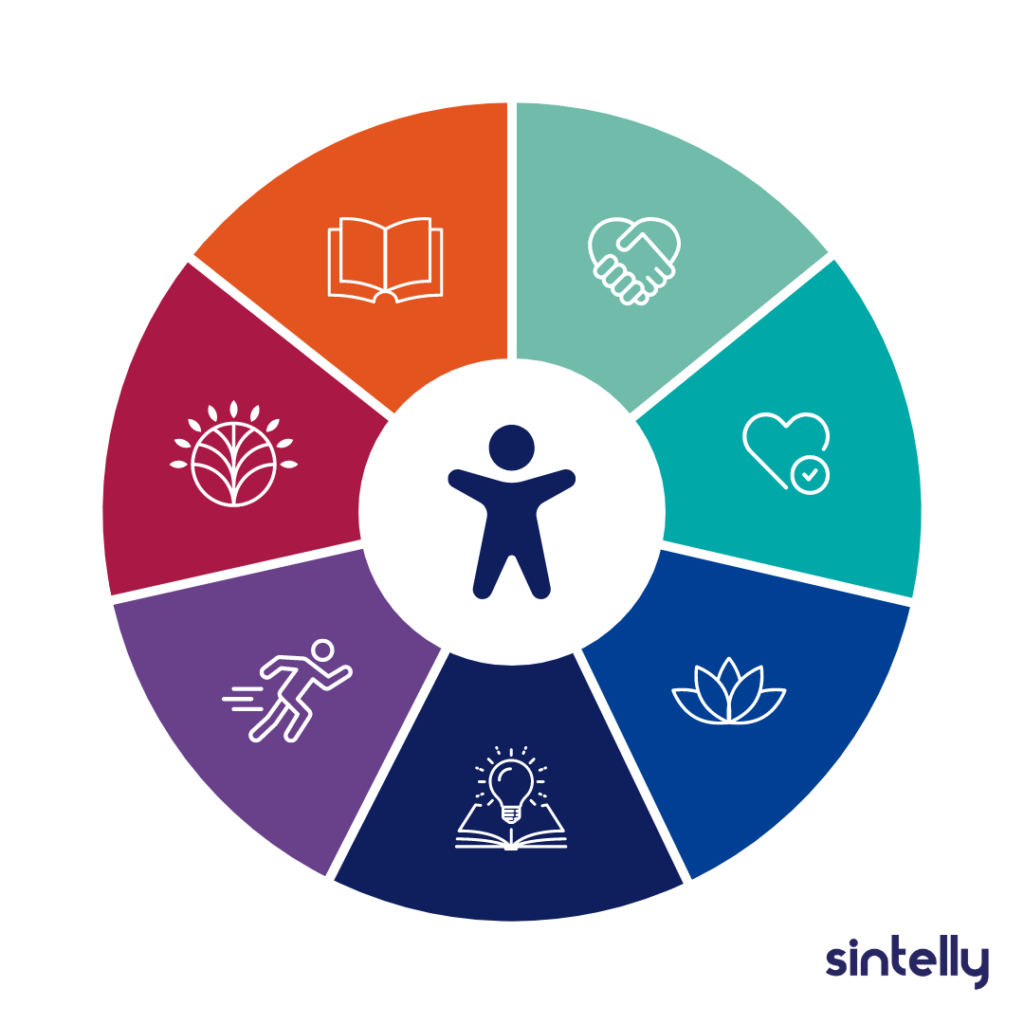Last Updated on September 6, 2023
In our fast-paced world, achieving wellness has become a cornerstone for those seeking a fulfilling and harmonious life. Picture a wheel divided into seven slices, each representing a unique dimension of wellness. This article explores these dimensions, offering insights, practical tips, and real-world examples. By understanding and embracing the wellness 7 dimensions, you can embark on a journey of holistic well-being.
Understanding the Wellness 7 Dimensions: A Holistic Approach
Before we delve into the practical aspects, let’s explore the significance of these seven dimensions. They go beyond the superficial and delve into the intricacies of a balanced life. They encompass physical, mental, emotional, and spiritual well-being, forming the core of our overall health.

Emotional Wellness: Navigating Feelings and Connections
Emotional wellness involves navigating feelings and nurturing connections. A crucial aspect of this dimension is acknowledging and managing emotions in a healthy manner.
Practice gratitude journaling, engage in mindfulness meditation, attend emotional intelligence workshops, and cultivate empathy through active listening. By developing these habits, you can create a more positive emotional landscape and build meaningful relationships.
Spiritual Wellness: Finding Inner Purpose and Meaning
Spiritual wellness transcends religious boundaries, focusing on inner purpose and meaning. It’s about connecting with something greater than ourselves and understanding our place in the universe.
Dedicate moments for silent reflection, attend nature retreats, explore meditation techniques, and volunteer for causes aligned with your values. By nurturing your spiritual dimension, you can find solace, purpose, and a sense of interconnectedness.
Intellectual Wellness: The Journey of Continuous Learning
Intellectual wellness thrives on lifelong learning and cognitive engagement. It’s about expanding your horizons, embracing curiosity, and challenging your intellect.
Dive into diverse books, engage in online debates, brainstorm with colleagues, and visit museums to stimulate creativity. By adopting habits that foster intellectual growth, you can keep your mind sharp and open to new possibilities.
Physical Wellness: Nurturing a Balanced Lifestyle
Physical wellness encompasses exercise, nutrition, and mindful habits. It’s about maintaining a healthy body that supports your overall well-being.
Establish an exercise routine, experiment with healthy cooking, incorporate relaxation techniques like yoga, and explore outdoor activities. By making physical wellness a priority, you can boost your energy levels, enhance your mood, and reduce the risk of chronic illnesses.
Environmental Wellness: Fostering Eco-Conscious Living
Environmental wellness emphasizes eco-conscious choices and caring for the world around us. It’s about recognizing the impact of our actions on the environment and taking steps to preserve it.
Reduce plastic waste, conserve energy, join local clean-up efforts, and create a personal garden oasis. By adopting eco-friendly habits, you contribute to a healthier planet and a better future for generations to come.
Vocational Wellness: Fulfillment Through Meaningful Work
Vocational wellness revolves around finding fulfillment in meaningful work that aligns with your passions and skills. It’s about pursuing a career that brings you satisfaction and a sense of purpose.
Reflect on career aspirations, offer mentorship, attend industry events, and explore roles aligned with your skills. By nurturing your vocational dimension, you can experience professional growth and a sense of accomplishment.
Social Wellness: Building Meaningful Connections
Social wellness celebrates human connections and community engagement. It’s about cultivating healthy relationships and having a strong support network.
Organize social events, participate in charity activities, join clubs, and engage in local projects. By prioritizing social connections, you can experience a sense of belonging, reduce feelings of isolation, and create lasting memories.

Applying the Wellness 7 Dimensions in Daily Life
Imagine the 7 dimensions of wellness as interconnected gears within a grand machine. Elevating one dimension has a positive ripple effect, enhancing overall well-being. For instance, focusing on physical wellness can lead to improved emotional resilience and heightened cognitive function. When you incorporate habits from each dimension into your daily routine, you create a comprehensive strategy for holistic well-being.
Examples of Incorporating the Dimensions: A Real-World Perspective
See how these dimensions come to life in daily scenarios:
- Emotional Wellness: Start a gratitude journal to capture positive reflections and enhance emotional awareness.
- Spiritual Wellness: Dedicate a quiet space for daily moments of reflection and inner contemplation.
- Intellectual Wellness: Engage in online debates to challenge your perspectives and expand your intellectual horizons.
- Physical Wellness: Add a 10-minute stretching routine to your mornings to invigorate your body.
- Environmental Wellness: Participate in local clean-up events to contribute to a cleaner and greener community.
- Vocational Wellness: Attend industry webinars to expand your knowledge and stay up-to-date in your field.
- Social Wellness: Connect with friends and family through virtual game nights, strengthening your relationships.
Achieving Optimal Well-Being: A Holistic Pursuit
As these dimensions intertwine, a symphony of wellness emerges. By nurturing emotional, spiritual, intellectual, physical, environmental, vocational, and social well-being, you weave a rich tapestry of vitality. Integrate these tips and examples into your journey, and embark on a life of holistic well-being through the seven dimensions of wellness. Embrace the interconnectedness of these dimensions and create a harmonious and fulfilling life.








